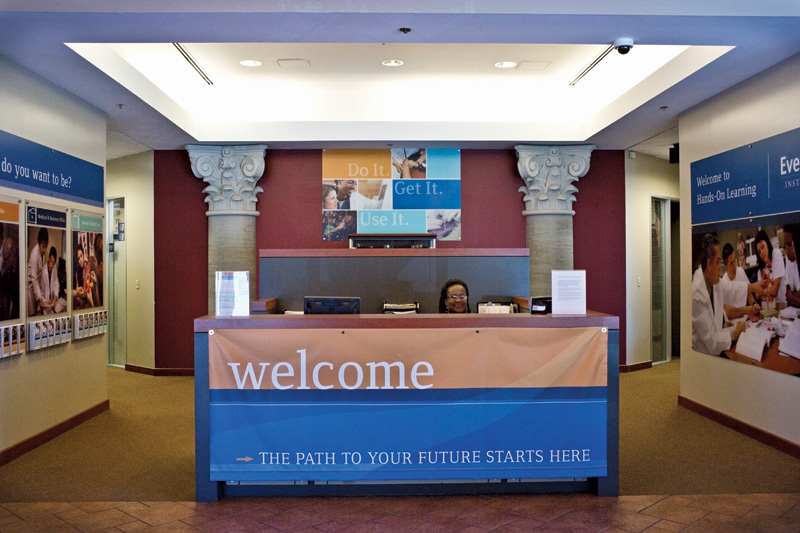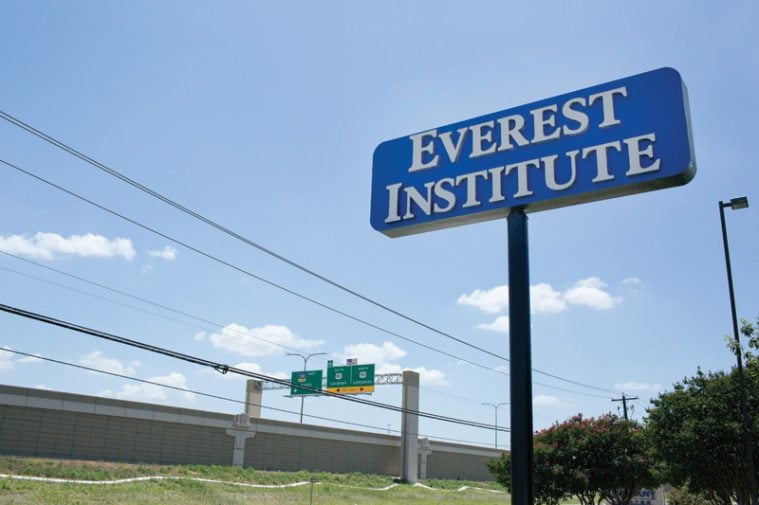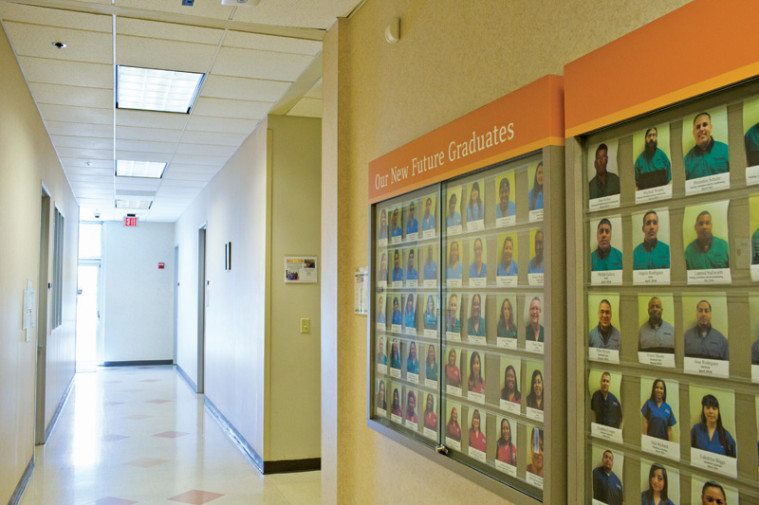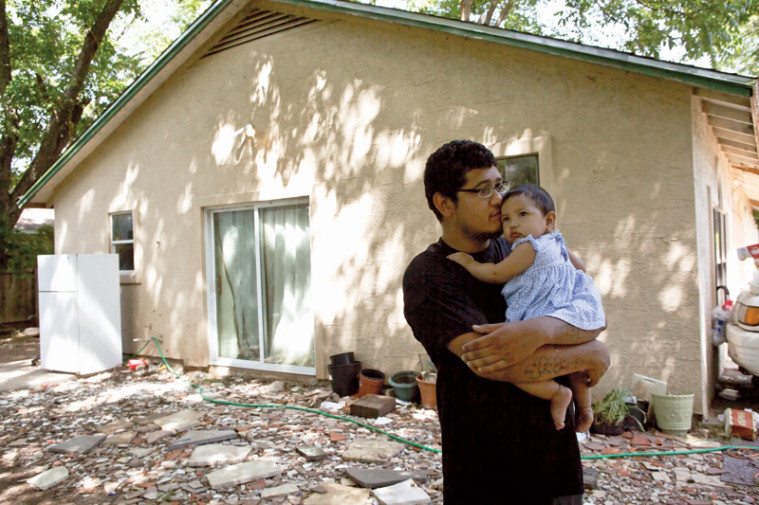
Can For-Profit Colleges Serve Students and the Bottom Line?

A version of this story ran in the August 2014 issue.
Above: The reception area at Everest Institute in Austin.
In January 2012, the Texas Workforce Commission instituted new state regulations to better monitor the business practices of for-profit colleges. (Publicy traded for-profit colleges, unlike state universities like the University of Texas and private nonprofit schools such as Rice University, are in business to make money for shareholders.) Among the rules is a requirement that school administrators be trained in “legal and ethical solicitation and enrollment of students.” Given the industry’s documented history of aggressively recruiting low-income students—in part to acquire their federal student aid—and offering substandard classes in return, critics had reason to celebrate the government’s tightening oversight. Whether these regulations work remains an open question.
I worked for most of the last decade in a college preparation program, and when I decided to learn more about how for-profit colleges operate, I contacted a former student, Erica Martinez. Martinez attended Everest Institute’s Austin campus in 2009. Everest is owned by Corinthian Colleges Inc., one of the largest for-profit college chains in the country. More than five years after she first contacted Everest, Martinez has two diplomas, thousands of dollars in student loan debt, and no career in her fields of study. Everest has collected thousands of dollars of federal student aid in her name, and millions more in the names of hundreds of thousands of students like her. Martinez’s experience prompted me to pay Everest a visit.
Just east of U.S. 290’s intersection with U.S. 183 on Austin’s northern edge, where 1960s-era suburban neighborhoods give way to industrial parks and undeveloped land, sits Everest Institute’s Austin “campus”—though the term is imprecise. Everest is housed in a Wal-Mart-sized facility with a Waffle House and a Jack in the Box visible from the school’s front door. Across the highway, hackberries and elms obscure the view of XTC Cabaret. There is no verdant quad on this campus.
The first thing I noticed were the 10-foot faux-Roman columns in the lobby. The receptionist welcomed me with a bright smile and a warm Otis Spunkmeyer chocolate chip cookie.
Over the years I’ve arranged dozens of college visits, but none were as easy to set up as my visit to Everest. I found the school’s phone number on the Internet and called. “Hello, we’re having a wonderful day at Everest!” a receptionist answered. I explained that I worked with high school students and would like to visit. I was quickly transferred to an admissions representative.
“Turns out it’s your lucky day,” the representative told me. A group of high school students would be touring the school the following day, and I could join them. As a bonus, the representative would arrange a one-on-one meeting with the director of admissions. All I needed to do was show up at 9 a.m.
The next morning I arrived 15 minutes early and parked at the end of the lot, not far from Waffle House. Walking through Everest’s main doors, the first thing I noticed were the 10-foot faux-Roman columns in the lobby. The receptionist welcomed me with a bright smile and a warm Otis Spunkmeyer chocolate chip cookie. Before I could accept, the phone rang, and she asked me to wait.
“Hello, we’re having a wonderful day at Everest!”
After transferring the call, she handed me an iPod with some short videos to watch while I waited to meet the director of admissions. The phone rang again.
“Hello, we’re having a wonderful day at Everest!”
The videos outlined the six degree programs on offer at Everest’s Austin campus: medical assistant; dental assistant; medical insurance billing; medical administrative assistant; electrical technician; and heating, ventilation, and air conditioning. (Two more programs—business accounting and information technology support specialist—have since been added.) A minute and a half long, each video featured an ethnically diverse mix of attractive people wearing scrubs or business attire, toting briefcases, shaking hands, operating lab equipment and smiling. A lot.
Each program employs the same pitch: It’s fast-paced and hands-on, and leads to career opportunities that are abundant and growing. The message couldn’t be clearer: Everest makes getting a great career easy.
After I finished the videos, Director of Admissions Chris Rios appeared as if on cue. Rios ushered me into a conference room with a drop-tile ceiling and wood veneer office furniture. He wore a trim suit, a closely cropped beard and a comfortable smile. “John,” he said, “I know you work with high school students, and I think Everest may be a great fit for your kids.”
He described Everest as hands-on, short term, career oriented, and “just a lot of fun.” Rios said that Everest would be a great step between high school and a traditional college for my students. He explained that a student wanting to become a nurse could get an Everest certificate and then work in the medical field while studying for a nursing degree.
Rios’ confidence and comfortable manner were assuring, but why, I wondered, would anyone wanting to become a nurse pay Everest $18,000 for a medical assistant diploma when a nursing degree from Austin Community College costs roughly $9,000? With the community college degree you can work as an actual nurse.
I asked Rios about his background and how he came to work at Everest. He told me he had worked in the mortgage industry directly out of high school, eventually landing a job at Ameriquest Mortgage. He left that job, he said, because he felt the company did “unethical things.” Ameriquest, one of the worst offenders of the subprime mortgage crisis, sold mortgages to people who could not afford them, helping trigger the economic collapse of 2008.
Rios also mentioned that he was taking classes at Austin Community College with the goal of transferring to and graduating from the University of Texas. It struck me as odd that someone without a college degree would be directing a college admissions department, but if this was indeed a contradiction, Rios didn’t seem to notice.

After our talk, Rios escorted me to a classroom where an admissions representative named Jenny (she didn’t give her last name) was preparing to give a presentation to a class of high school seniors. Their English teacher had agreed to bring the students in after hearing an Everest recruiter’s pitch during a faculty meeting.
As I entered the room, Jenny greeted me enthusiastically and handed me a thick, glossy folder. Molded plastic chairs and desks filled the space. Jenny, wearing a suit befitting a young urban professional, chatted with the students. I took a seat in the back of the room.
Jenny delivered a buoyant introduction: “I just love my job because I love helping students be successful!” She then asked the students to share their post-high school plans. One mentioned the Army, a kid with a Toy Story book bag mentioned Austin Community College, and a large young man said he planned to attend the University of Oklahoma on a football scholarship. Everyone perked up when the large kid spoke. Even though they were second-semester seniors, most of the students didn’t have a plan for the fall.
Jenny segued to Everest’s offerings. “Don’t feel bad if you don’t know what you want to do after graduation,” she said. “I didn’t either, and that’s why Everest is here!” The classroom was rapt. No half-open eyes or uninterested stares. She told us that our folders contained information about the six Everest programs, and that we would discuss several of them.
“In the back of the folder there is some disclosure information with a lot of good info,” she continued, “but we don’t have time to go over it.”
As Jenny sang the praises of Everest’s electrical technician program, I flipped through the disclosure pamphlet and noticed an interesting detail: The on-time completion rate listed for the program was 4 percent. Completion rates are considered a measure of how well a college supports its students.
Jenny had not asked if we had any questions, but I raised my hand anyway. After not being called on for five minutes, I grabbed my elbow to prop up my tiring arm.
Finally, she called on me.
“Could you tell me more about the 4 percent on-time completion rate of the electrical technician program?” I asked, using a nonconfrontational tone.
Jenny paused, and paused, and paused—the first time the perfectly scripted quality of her speech had faltered.
“Oh, I didn’t know about that,” she finally responded. She paused again. “I think that number is wrong; that number is probably wrong.” She furrowed her brow. “Yeah, that number is probably wrong,” she added again, as if to convince herself.
The 4 percent on-time completion rate was not the only troubling statistic I encountered while researching for-profit colleges. According to the U.S. Department of Education, 72 percent of for-profit colleges produce graduates who on average earn less than high school dropouts. And while for-profit college students account for 13 percent of students in post-secondary education nationwide, they also account for nearly half of student loan defaults. Critics argue that if these institutions were truly preparing students for gainful employment, their students would be better able to repay their student loans.
After Jenny’s presentation, I toured the facility with the high school students. Walking through the quiet hallways, we passed several motivational posters and a small group of students wearing scrubs. I noticed none of the distinguishing markers of a traditional institution of higher education: no student center, cafeteria or library.
At the end of a hallway we entered a classroom furnished with lab tables and a life-sized plastic skeleton. We stood, crammed side by side, while a medical assistant instructor addressed us. The pitch was familiar: Everest is hands-on and a lot of fun. After her speech, she entertained the high school students with gory tales from her time working in a hospital.
At the end of the tour, I received a complimentary coffee mug and a firm handshake from Rios, and was sent on my way. Sitting in my car in the parking lot, I contemplated what had transpired. The surfeit of smiles, the seemingly mandatory cheer, the whole here-to-help-you-succeed shtick endowed my visit with the ambience of a long-form infomercial.

This sort of educational predation is not new. Governmental policy aimed at democratizing access to college—first through the establishment of publicly funded state universities, and in 1944 with the G.I. Bill—has historically reflected the belief that higher education provides a path to the middle class. The G.I. Bill gave veterans grants to study at institutions of their choosing. As is the case with many federally sponsored social welfare programs, the G.I. Bill was quickly exploited: Fly-by-night for-profit colleges sprang up across the country to collect the funds trickling down from the bill.
Internal company documents describe Everest’s target demographic as “isolated,” “impatient” individuals with “low self-esteem” who have “few people in their lives who care about them.”
Both the federal and state governments (via the U.S. Department of Education and the Texas Workforce Commission, respectively) are responsible for regulating for-profit colleges. Rules have waxed and waned over the years.
With the exponential growth of for-profit colleges and increasing levels of student debt becoming important political and economic issues, in 2011 the Obama administration attemped to protect students from predatory schools by issuing so-called gainful employment regulations. Colleges would have to prove they prepared students for employment or they would lose access to federal student aid. That aid is the lifeblood of for-profit colleges. In August 2012, Iowa Sen. Tom Harkin, perhaps the industry’s most prominent critic, released a report estimating that publicly traded companies operating for-profit colleges receive 86 percent of their revenue from federal student aid.
The gainful employment regulations were a potentially historic moment in higher education policy. But the regulations—a good idea in theory—were lax. A college would be considered in good standing if just 35 percent of its former students were repaying their loans.
Despite this leniency, the Association of Private Sector Colleges and Universities sued the U.S. Department of Education. In July 2012, a federal judge ruled that the 35 percent benchmark was “arbitrary” and threw out the rule. He did, however, uphold a requirement that colleges disclose completion rates to students.
The Texas Workforce Commission instituted new state requirements in January 2012. They were in part a response to fraud uncovered by reporter Byron Harris of WFAA-TV in Dallas. Harris not only reported that for-profit schools falsify job-placement rates, provide substandard classes, and solicit students at homeless shelters, he also exposed a lack of oversight by the commission.
The Texas Workforce Commission now requires ethics training for school officials and a streamlined complaint process, among other regulations. But Harris told me by phone that emails from disgruntled for-profit college students continue to fill his inbox.
This March, the Obama administration proposed new gainful employment regulations. Predictably, the for-profit college industry is spending hundreds of thousands on lobbyists to fight them. If past is prologue, industry interests will prevail.
A week after my visit to Everest, I met with Erica Martinez again. She was a diligent student in high school and as a senior earned admission to the University of Texas-Pan American. She would have been the first in her family to attend college, but, fearful of leaving home, Martinez, in her words, “chickened out.”
That fall, after high school graduation, when she could have been living in a dorm, attending study groups, and reading on the quad between classes, Martinez was floundering—no college, no job and no plan. One day she was watching The Maury Povich Show, part of her daily routine, when a commercial caught her attention.
Forty-eight hours later, with the help of an Everest representative, she had completed a student-aid application and enrolled in Everest’s medical billing program. Since new classes (Everest calls them “modules”) begin each month, she found herself sitting in front of an Everest instructor the following week. Martinez sailed through her modules with a 4.0 GPA and received her diploma nine months later. But after a year of job hunting she could not find a permanent position.
“I got so fed up,” Martinez said. “I looked every day and couldn’t find anything.”
Martinez’s struggle is not unique among Everest graduates, and the schools have gone to great lengths to hide this. According to a Huffington Post report, several Everest campuses have paid companies to temporarily hire graduates in an effort to inflate job- placement rates.
Huffington Post reporter Chris Kirkham spoke to former Everest employees from six different states who confirmed that an array of tactics are used to create a “culture of data manipulation” at the schools.
“I was directly told, ‘You need to find a company that is willing to take on your students for a short period of time, and who cares if they stay?’” one former Everest employee told Kirkham.
Like most Everest students, Martinez did not know about this history of manipulation. After failing to find a job she was not sure what to do, so she called Everest again. A representative told her not to worry; the school had another program, medical assisting, which would be a great fit. He assured her that with a medical assistant diploma she would almost certainly get a job. Nine months later, Martinez had obtained that diploma—and $9,000 more in student loan debt. A medical assistant job has yet to materialize.
In the process of writing this piece, I came across numerous stories of students like Martinez—former for-profit college students unable to find jobs in their field of study and saddled with thousands of dollars of student loan debt.
Karen Hornsby, a 56-year-old recovering alcoholic who lives in Jarrell, said an admissions representative gave her the hard sell while she was visiting Everest’s Austin campus with a friend. Hornsby worked full time at a Subway restaurant; the representative suggested she take weekend classes. She could complete the medical assisting program in eight months. All she had to do was attend class each Saturday and Sunday—10 hours each day. Despite the grueling schedule, Everest started to sound like an appealing opportunity for a single woman fighting to firm up her shaky fingerhold in the middle class.
Hornsby maintains the lilt and look of rural Texas—she was born in Snyder, a small town in the western part of the state—and she possesses the roughhewn awareness that a battle with the bottle, numerous jobs, and 25 years of sobriety can provide. Over a cup of coffee in the Jarrell Subway, she said she quickly realized Everest was a “diploma mill.” During one class, students were directed to draw blood from a partner. The professor distributed gloves, tourniquets, wipes, gauze and syringes, but not much instruction on how to draw blood.
“Blood was everywhere,” Hornsby said. “One big fella from Lampasas had this huge vein that squirted blood clear across the room.”
Hornsby said classes were disorganized and student cell phones were a constant distraction. “One went off every 10 minutes.” She was appalled when she discovered that completed tests were thrown in the trash with no grades recorded. She quit at the end of her first module.
Disturbed by the experience, Hornsby emailed the president of the school, Kimberly Oppermann. She called Everest classes “substandard,” described the cost as “outrageous,” and asked that the school refund her student aid to the government.
I emailed Oppermann to ask if she could refer me to graduates who are happy with their Everest experience and have secured careers in the industry of their training. She has not responded. (Oppermann has since left Everest to become vice president of a for-profit college in Florida.)
The student I met who best embodies the aspirational ethos that for-profit colleges such as Everest appeal to is 22-year-old Everardo Garcia. Raised by his grandmother—his parents were only sporadically involved in his childhood—Garcia is, by constitution, a sweet-natured optimist.
Why, I wondered, would anyone wanting to become a nurse pay Everest $18,000 for a medical assistant diploma when a nursing degree from Austin Community College costs roughly $9,000?
After graduation Garcia worked in construction with his uncles and earned $30,000 his first year. Life was good, but the incessant phone calls from Everest irritated him.
“They just wouldn’t stop blowing up my phone,” Garcia said.
Recruiters had called weekly since they got his number.
Kind to a fault, he didn’t tell them to stop, just that he wasn’t interested in attending. When the phone calls continued into a second year, he finally agreed to visit the school. “Just to see how it’s like,” he said.
During that visit a recruiter told Garcia that young people like him are the future, and Everest wanted him to do something with his life. The recruiter explained the difference between a job and a career and then posed questions that resonated with Garcia: Why work a construction job when he could have a rewarding profession? Was he willing to make an investment in his future?
Garcia was finally hooked. Two days later he signed a student-aid application that an Everest adviser helped him complete. A week later Garcia was attending his first module on the way to earning a diploma in dental assisting, a program he chose after watching the same short videos I watched during my visit to Everest.
During my first meeting with Garcia, he showed me the awards he had received at Everest: two perfect-attendance awards and three director’s list awards. He proudly told me that making the director’s list is like making the honor roll.
Garcia did not pay money out of pocket to attend Everest—at least not initially. He qualified for a federal Pell grant of more than $5,000 and federal loans totaling almost $15,000. (Pell grants are need-based assistance intended to help low-income students attend college.) Garcia won’t have to start repaying his loans until six months after he leaves Everest.
According to company documents, program costs at Everest-Austin average more than $18,000 per student—a number that includes tuition, fees, books and supplies. Median graduate debt is almost $13,000.
Garcia will finish the dental assisting program this month. I asked him if he’s worried about repaying the $15,000. “Not at all,” he said. “They told me this is an investment in myself, and I’ll be making a whole lot more money when I finish.”

Can educational institutions effectively serve students while maximizing shareholder value? Are private enterprise and education fundamentally incompatible?
Consider Sen. Harkin’s report on the for-profit college industry. “In this report,” Harkin said in a statement, “you will find overwhelming documentation of exorbitant tuition, aggressive recruiting practices, abysmal student outcomes, taxpayer dollars spent on marketing and pocketed as profit, and regulatory evasion and manipulation. These practices are not the exception—they are the norm.”
Last October, California Attorney General Kamala Harris filed suit against Everest’s parent company, Corinthian Colleges Inc. “The predatory scheme devised by executives at Corinthian Colleges, Inc. is unconscionable,” Harris said in a press release. “Designed to rake in profits and mislead investors, they targeted … particularly vulnerable people…”
Harris’ complaint highlights internal company documents that describe Everest’s target demographic as “isolated,” “impatient” individuals with “low self-esteem” who have “few people in their lives who care about them” and who are “stuck” and “unable to see and plan well for future.”
Allowing profit-focused corporations access to public funds intended to promote educational equality has, in fact, created a predatory system and further entrenched educational inequality. For-profit college students struggle to find gainful employment, and CEOs of publicly traded higher education companies rake in multimillion-dollar salaries. In 2013, Jack Massimino, Corinthian Colleges Inc.’s CEO, took home $6.5 million in compensation.
While students like Martinez labor to pay off their student loans, for-profit colleges manipulate prospective students, game the financial-aid system, and lead those who can least afford it into debt.
In June, the U.S. Department of Education dropped a bombshell. Citing Corinthian Colleges Inc.’s failure to respond to requests for information about questionable practices, including falsifying job-placement rates, the department halted the company’s access to federal student-aid funds.
On July 3 an agreement was reached. Under the terms of the deal, Corinthian Colleges Inc. will sell 85 campuses and close 12 others. In return, the Department of Education will release $35 million in student aid to the company, funding its operation while it looks for buyers.
Everest-Austin is slated to be sold.
While this federal action may spell the end of Everest as we know it, it does not fundamentally address the industry-wide pattern of abuse. And it does little for students like Martinez, Hornsby and Garcia.
Erica Martinez and Karen Hornsby are pseudonyms used to protect privacy.


